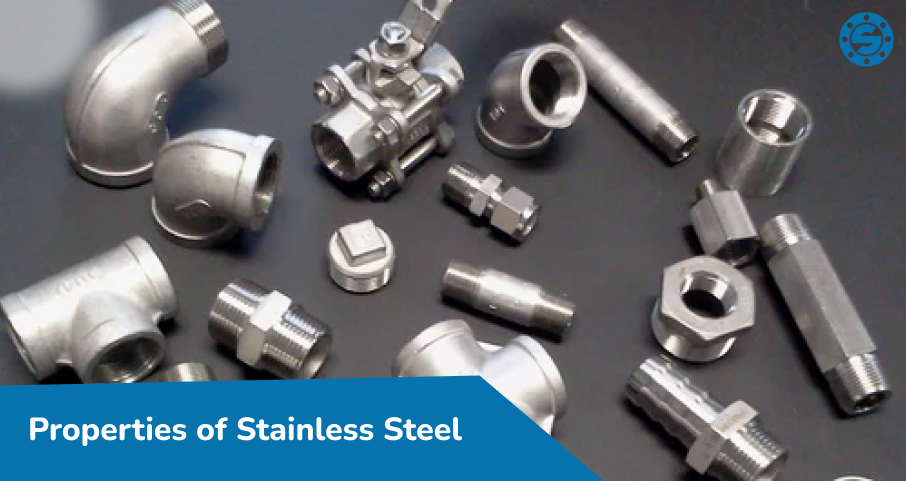Properties of Stainless Steel

Stainless steel is well-known for its corrosion-resistant properties, making it a non-corrosive and rust-resistant material. which is simply designated as stainless steel. In this comparison with aluminum, stainless steel is approximately 3 times heavier.
Like regular steel, stainless steel is an alloy, meaning it is made from a combination of different elements. One of the main components of non-corrosive stainless steel is chrome. Other key elements, such as nickel and molybdenum, are added to meet specific performance requirements.
Two key properties of stainless steel are its magnetic ability and its corrosion resistance, both of which are influenced by the alloy composition.
Uses and Properties of Stainless Steel
Steel with more than 10.5% chromium, along with other elements in smaller amounts, is classified as stainless steel. When exposed to oxygen, the chromium forms a thin, protective chromic-oxide layer, known as the passive layer, which provides the material’s corrosion resistance. This resistance makes stainless steel ideal for various applications, such as washing drums.
In terms of properties, rust-resistant stainless steel is similar to anodized aluminum. However, if the surface layer is damaged, both the material and its surface can be affected.
Benefits of Stainless Steel
- Strength : Stainless steel is known for its exceptional strength, even at extreme temperatures, making it ideal for demanding industries like aviation.
- Easy to Clean : Being one of the most hygienic materials, stainless steel doesn’t support bacteria growth and is easy to clean and sterilize. This makes it perfect for use in kitchens and medical environments, where quick cleaning with basic cleaners is often enough.
- Aesthetics : Beyond its strength, stainless steel has a modern, sleek appearance. Its clean look enhances both classic and contemporary designs, making it popular in architectural applications.
- Corrosion Resistance : Stainless steel is highly resistant to rust and water stains, making it suitable for both indoor and outdoor use, even under extreme conditions. This resistance is due to the chromium content, which forms a protective layer when exposed to oxygen.
- Recyclable : Stainless steel is highly sustainable, as most of it is made from recycled materials. Its properties remain intact through recycling, allowing it to be reused without any loss in quality, benefiting both manufacturers and the environment.
Stainless Steel Applications
- Automotive and Transportation
Stainless steel was first used in the automotive industry in the 1930s by Ford for concept cars. Today, it is widely used to make car parts like exhaust systems, grills, and trims. With advancements in technology, manufacturers are increasingly using stainless steel for structural components. In transportation, it’s essential for shipping containers, road tankers, and refuse vehicles due to its corrosion resistance, making it ideal for transporting chemicals, liquids, and food products. Its low maintenance also makes it cost-effective. - Medical Technology
Stainless steel is ideal for clean and sterile environments because it is easy to clean and highly resistant to corrosion. It is commonly used to make surgical and dental instruments, as well as operation tables, kidney dishes, MRI scanners, and sterilizers. Stainless steel is also used for surgical implants like replacement joints and artificial hips, and in pins and plates for bone repair. - Building Trade
Thanks to its strength, corrosion resistance, and flexibility, stainless steel has become an important material in construction. It is commonly used for countertops, backsplashes, handrails, and cladding on high-impact buildings. Its weldability, low maintenance, and aesthetic appeal have made it a popular choice in modern architecture, as seen in the Eurostar Terminal in London and the Helix Bridge in Singapore. With sustainability in focus, stainless steel’s recyclability makes it a preferred choice in construction. - Aircraft Construction
In aviation, stainless steel is valued for its strength and temperature resistance. It is used in airplane frames, jet engines, and landing gear because it can withstand extreme conditions and resist rusting. - Food and Catering Industry
In the food industry, stainless steel is used to make kitchen tools, cookware, and cutlery. Less ductile grades are used for knives, while more ductile ones are ideal for grills, cookers, and sinks. Stainless steel is also found in freezers, dishwashers, refrigerators, and countertops. It doesn’t affect the taste of food, is corrosion-resistant, and can hold acidic drinks. Its ease of cleaning makes it ideal for food storage as it prevents bacteria buildup.
Grades Stocked
304 / 1.4301
- Good corrosion resistance and formability
- Non-magnetic
316 / 1.4401
- Excellent corrosion resistance
- Good formability
- Non-magnetic
430 / 1.4016
- Cost-effective stainless steel
- Fabricates well
- Magnetic
409 / 1.4512
- Suitable for high-temperature applications like exhaust systems
- Magnetic and fabricates well
304L / 1.4307
- Good corrosion resistance and formability
- Non-magnetic
Stainless Steel Properties Summary
Stainless steel is known for its strength, corrosion resistance, and durability. It withstands extreme temperatures, resists rust due to its chromium content, and is easy to clean, making it ideal for hygienic applications like kitchens and medical equipment. Additionally, it has a sleek, aesthetic appearance, making it popular in architecture. Stainless steel is also highly recyclable, maintaining its properties even after being reused.
FAQs
Stainless steel is highly resistant to corrosion, making it ideal for transporting chemicals, liquids, and food products. Its low maintenance and ease of cleaning make it a cost-effective choice, especially in sterile environments, where hygiene and durability are crucial.
Austenitic stainless steel, known for its corrosion and heat resistance, is commonly used in a variety of applications, including housewares, industrial piping, vessels, construction, and architectural facades due to its excellent mechanical properties over a wide temperature range.
Stainless steel has a higher initial cost compared to lower-quality materials, but its long-term advantages include superior durability, corrosion and heat resistance, high tensile strength, and hygienic properties, resulting in lower overall costs over time.


